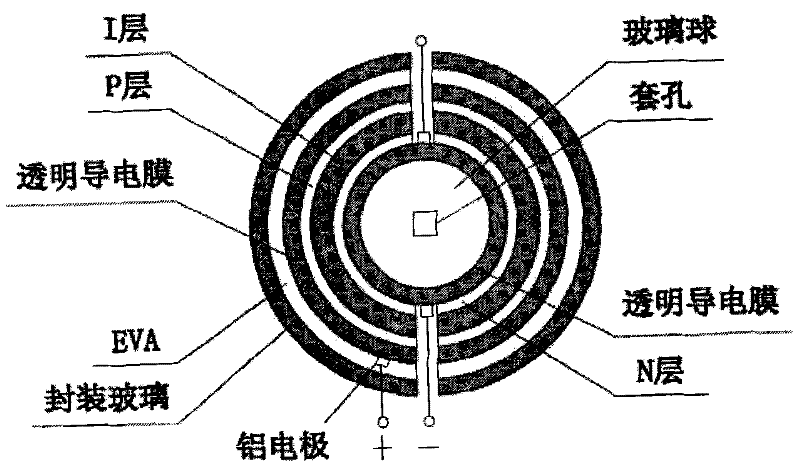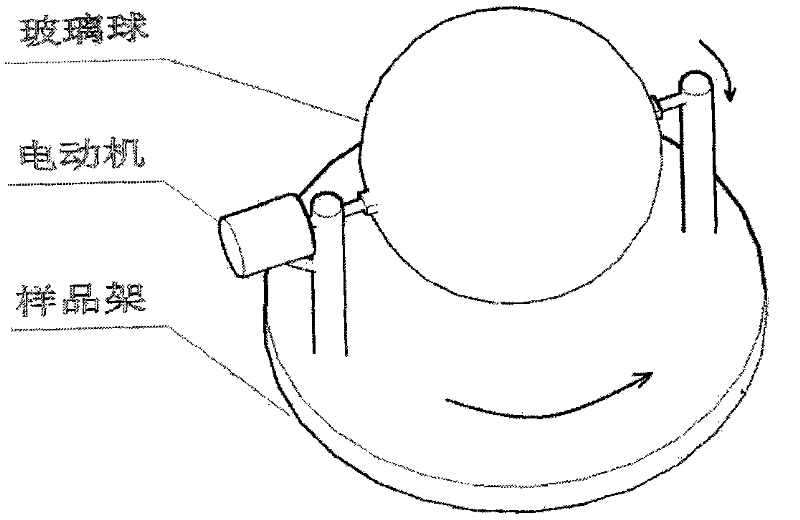Spherical thin-film solar cell, preparation method thereof and spatial arrangement assembly based on cell
A technology of thin-film solar cells and thin-film batteries, which can be applied to circuits, photovoltaic power generation, electrical components, etc., and can solve problems such as inability to absorb sunlight to the maximum
- Summary
- Abstract
- Description
- Claims
- Application Information
AI Technical Summary
Problems solved by technology
Method used
Image
Examples
Embodiment 1
[0044] 1. Structural design of solar cells
[0045] The diameter of the glass sphere is 10cm, and a 50nm-thick ITO film is sequentially grown on the glass sphere, hydrogenated nano-silicon NIP structure (N, I, P layer thicknesses are 10, 400, 10nm, respectively), and a 70nm-thick Al x Zn 1-x O(x=0.02) thin film, lead out aluminum electrodes, and finally use EVA and two hemispherical glass for encapsulation. (Such as figure 1 shown)
[0046] 2. Preparation of solar cells
[0047] 2.1 Cleaning of glass balls
[0048] The glass spheres were ultrasonically cleaned with acetone, rinsed with deionized water, and dried.
[0049] 2.2 Preparation of transparent bottom electrode by sputtering method
[0050] The background vacuum of the sputtering chamber is 1×10 -4 Pa, use the sputtering method to sputter the ITO ceramic target on the cleaned glass ball, and deposit the ITO film with a thickness of about 50nm. Glass spheres are mounted on a three-dimensional sample stage (such ...
Embodiment 2
[0066] Structural Design of Solar Cells
[0067] The diameter of the glass sphere is 10cm, and the ITO film with a thickness of 50nm is grown successively on the glass sphere, and the amorphous silicon / microcrystalline silicon laminated battery (the N, I, and P layer thicknesses of the microcrystalline silicon bottom battery are 10, 1000, 10nm respectively, The thickness of the N, I, and P layers of the amorphous silicon top cell is 10, 200, and 10nm respectively), and the 70nm thick Al x Zn 1-x O(x=0.02) thin film, lead out aluminum electrodes, and finally use EVA and two hemispherical glass for encapsulation. (Such as figure 2 )
[0068] The difference from Embodiment 1 is that the thin film battery adopts the laminated structure of amorphous silicon / microcrystalline silicon film and uses the PECVD method to prepare hydrogenated amorphous silicon / microcrystalline silicon laminated battery on the bottom electrode.
[0069] Glass spheres are mounted on a three-dimensional...
PUM
 Login to View More
Login to View More Abstract
Description
Claims
Application Information
 Login to View More
Login to View More - R&D
- Intellectual Property
- Life Sciences
- Materials
- Tech Scout
- Unparalleled Data Quality
- Higher Quality Content
- 60% Fewer Hallucinations
Browse by: Latest US Patents, China's latest patents, Technical Efficacy Thesaurus, Application Domain, Technology Topic, Popular Technical Reports.
© 2025 PatSnap. All rights reserved.Legal|Privacy policy|Modern Slavery Act Transparency Statement|Sitemap|About US| Contact US: help@patsnap.com



